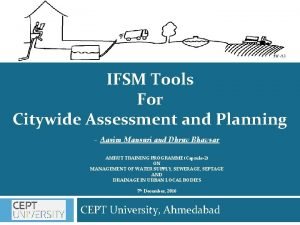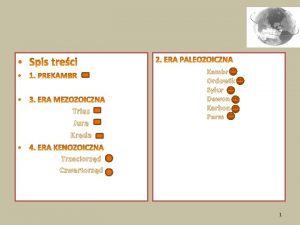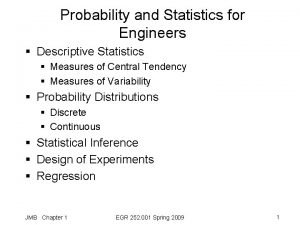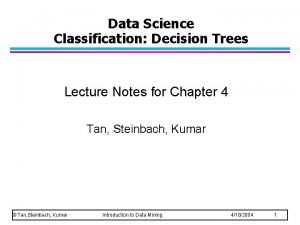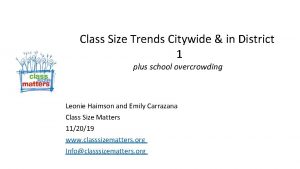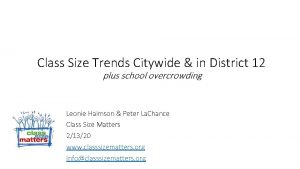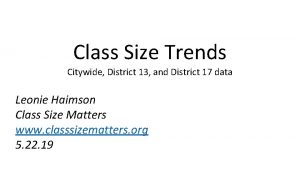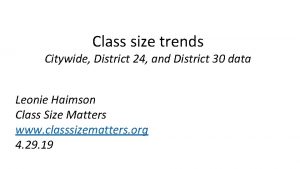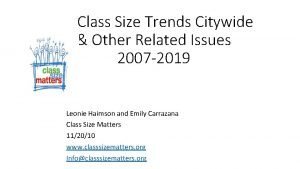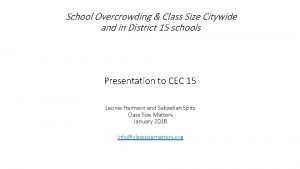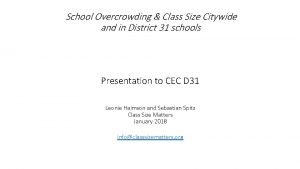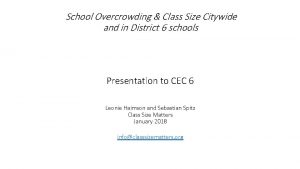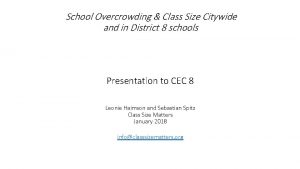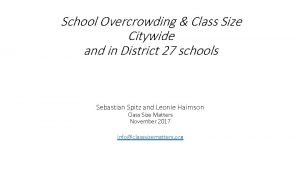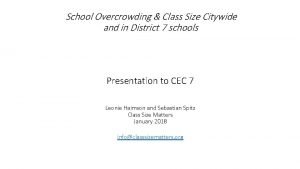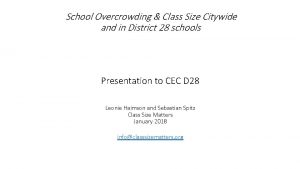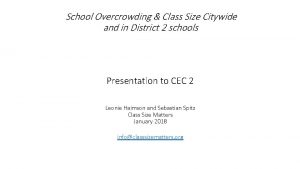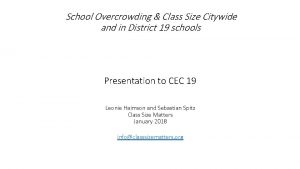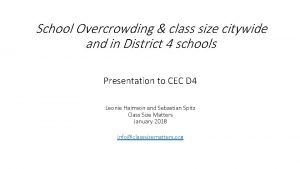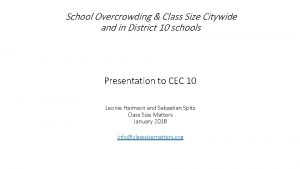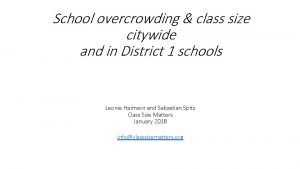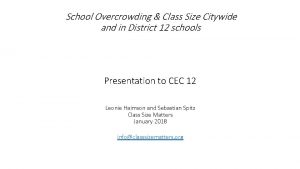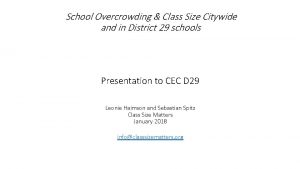Class Size Trends Citywide in District 22 plus























- Slides: 23

Class Size Trends Citywide & in District 22 plus school overcrowding Leonie Haimson Class Size Matters 1/6/20 www. classsizematters. org Info@classsizematters. org

25 students per class in Kindergarten What are the UFT contractual class sizes limits? 32 students per class in elementary grades In Title I middle school, 30 students per class, 33 in non-Title I MS 34 students per class in high school core academic classes These class size caps have not been lowered in 50 YEARS! Even so, hundreds of classes violate the union contractual caps each year.

At least 29, 133 – 67, 648* students were in classes over UFT limits as of Oct. 31, 2019 6, 431 5, 876 4, 344 4, 222 3, 405 3, 293 1, 562 K 1 st-3 rd 4 th-8 th HS ELA HS Math HS Science *the lower figure uses 33 students as class size cap for non-Title I MS; the higher figure uses 30 as cap for Title I MS. HS Soc. Studies

In 2007, NYS Legislature passed a new law called the Contracts for Excellence (C 4 E)

C 4 E law states that in return for millions in new state funding, NYC has a legal obligation to: 1. Spend the funds to improve school conditions in six specified areas. 2. Create a plan to gradually reduce class sizes in all grades over five years in three grade spans. 3. In 2007, NYC submitted a 5 -yr plan to reduce class sizes to no more than 20 in grades K-3; 23 in grades 4 -8 and 25 in core HS classes. 4. Yet instead of decreasing, class sizes increased sharply, starting in 2008.

Average K-3 Class Sizes Citywide & D 22 Citywide have increased 13. 3% since 2007 D 22 have increased 6. 2% since 2007 26 25. 5 25 24. 6 23. 2 23 22 21 20 19 21. 8 21. 3 21. 0 22. 2 25. 5 25. 0 24. 5 24 25. 6 24. 9 24. 7 24. 6 23. 9 25. 2 24. 2 25. 1 24. 8 25. 2 24. 0 23. 9 23. 8 19. 9 22. 1 21. 2 21. 4 20. 9 20. 7 20. 5 20. 3 20. 1 19. 9 Baseline 2007 -8 2008 -9 2009 -102010 -112011 -122012 -132013 -142014 -152015 -162016 -172017 -182018 -192019 -20 C 4 E goals Citywide actual D 22

Average 4 th-8 th Class Sizes Citywide & D 22 Citywide have increase 3. 5% since 2007 D 22 slightly lower than in 2007 but are far higher than C 4 E goals 29 28 27 28. 2 27. 0 26. 5 26 25 24 23 22 27. 4 25. 6 26. 5 25. 1 26. 7 26. 3 28. 2 28. 1 27. 5 27. 6 26. 7 26. 8 26. 7 22. 9 27. 8 26. 8 27. 5 27. 4 26. 6 26. 5 22. 9 25. 8 25. 3 24. 8 24. 6 23. 8 23. 3 Baseline 2007 -8 2008 -9 2009 -102010 -112011 -122012 -132013 -142014 -152015 -162016 -172017 -182018 -192019 -20 C 4 E goals Citywide actual D 22

Average HS Class Sizes Increased 2% Since 2007 28 27 26. 6 26. 2 26. 1 26 26. 5 26 26. 4 26. 3 24. 5 26. 7 26. 8 24. 5 26. 7 26. 5 26. 4 24. 5 25. 7 25 25. 2 24. 8 24 24. 5 C 4 E Target 0 -2 20 01 -2 18 20 Citywide Actual 19 9 8 -1 17 16 20 20 -1 7 6 -1 20 15 5 -1 14 20 20 13 -1 4 3 -1 20 12 2 -1 20 11 1 -1 10 20 20 09 -1 0 9 -0 08 20 20 07 -0 8 23

But average class sizes only tell part of the story! The total number of students in classes of 30 or more citywide has also increased since 2007.

Number of Kindergarten students in classes of 25 or more has increased 68% since 2007 18, 768 20, 000 16, 000 12, 000 11, 174 8, 000 4, 000 0 2007 2019

Distribution of Kindergarten Students in Classes of 25 or More 1800 1600 1400 1200 1000 800 600 400 200 0 1 2 3 4 5 6 7 8 9 10 11 12 13 14 15 16 17 18 19 20 21 22 23 24 25 26 27 28 29 30 31 32 District

Number of 1 st-3 rd graders in classes of 30 or more has increased by 2, 893% since 2007 40, 000 35, 471 30, 000 20, 000 1, 185 0 2007 2019

Distribution of 1 st-3 rd Grade Students in Classes of 30 or More 4000 3500 3000 2500 2000 1500 1000 500 0 1 2 3 4 5 6 7 8 9 10 11 12 13 14 15 16 17 18 19 20 21 22 23 24 25 26 27 28 29 30 31 32 District

Number of 4 th-8 th graders in classes of 30 or more has increased by 35% since 2007 112, 250 120, 000 100, 000 83, 055 80, 000 60, 000 40, 000 20, 000 0 2007 2019

Distribution of 4 th-8 th Grade Students in Classes of 30 or More 12000 10000 8000 6000 4000 2000 0 1 2 3 4 5 6 7 8 9 10 11 12 13 14 15 16 17 18 19 20 21 22 23 24 25 26 27 28 29 30 31 32 District

So what are we doing about this? • . In July 2017, CSM along with 9 NYC parents & AQE filed a complaint with the State Education Commissioner to demand they enforce the C 4 E and require NYC to lower class size. In April 2018, after the Commissioner ruled against us, so we followed up with a lawsuit vs. the city and the state in the NYS Supreme Court. Though Judge Henry Zwack ruled that the Commissioner’s decision to allow NYC to increase class size should be given deference, we appealed the case to the Appellate Court in May 2019. Hearings were held at the NY Appellate Court in Albany on January 13, 2020.

School overcrowding also an issue in many districts including D 22. • C 4 E regs require capital plan be aligned with DOE’s class size reduction plan. • Data in Blue Book shows that last year, there were 524, 467 students in NYC schools at 100% utilization or more. • This is 53. 2% of all NYC students. • Though in some districts, there would be space to lower class size right now, probably not in most D 22 schools.

There were 18 District 22 Elementary Schools at or Above 100% Utilization in 2018 -2019 (& one co-located charter school) 180% 153% 160% 147% 143% 137% 134% 140% 122% 120% 117% 116% 113% 112% 111% 110% 108% 104% 102% 120% 100% 80% 60% 40% 20% P. S. 31 5 5 P. S. 24 4 19 S. P. 52 S. P. S. 23 6 7 21 S. Y -N H AC BE GE N ER -B SA P. 4 7 S. P. S. 11 20 9 9 13 S. P. 7 27 S. P. S. 13 4 7 20 S. P. S. 32 6 5 25 S. P. S. 13 4 6 20 S. P. 54 S. 2 P. S. 19 5 0%

There were also six District 22 Middle and High Schools at or above 100% Utilization in 2018 -2019 350% 317% 300% 250% 201% 200% 169% 150% 116% 109% 100% 50% 0% I. S. 234 KINGSBOROUGH EARLY COLLEGE SCHOOL BROOKLYN COLLEGE JAMES MADISON HS ACADEMY - K K MIDWOOD HS - K LEON GOLDSTEIN HS K

Despite overcrowding and large class sizes, the Capital Plan decreased funded seats in many districts between Feb. 2019 and Nov. 2019 • The Nov. 2019 proposed amendment to the Five-Year Capital Plan appears to increase by 572 funded seats but actually eliminates 1, 772 seats for Districts 1 -32 and HS. • 2, 344 seats for D 75 special education are now included in the total, though not in the Feb. 2019 Capital Plan. • D 22 lost 298 seats between the Feb. 2019 and Nov. 2019 version– all seats planned for subdistrict Flatlands/Midwood/East Flatbush • Mill Basin subdistrict increased by 184 to 824 seats. • All the D 22 seats are apparently unsited – as not listed “in process. ”

School siting taskforce created by Local Law 168 • Met only twice with no input from parent or City Council members. • Produced a 2 -page report which we FOILed, along with two spreadsheets. • Out of 29, 509 city-owned sites investigated in NYC, only two locations were deemed possible & will be investigated as sites for new schools, one in D 21 and the other in D 23. • Sites were removed from consideration for a variety of reasons, including being underwater, not meeting size requirements, not needed, or not being city-owned. • The SCA did yet not review over 75% (22, 000+) of identified empty lots because they’re not City-owned, claiming that these will be looked at “in the near future. ”

27 sites for D 22 were investigated, and all were deemed unacceptable for the following reasons: D 22 School Sites • Land not usable (waterfront, irregular size, etc. ) • Land not available • Not city-owned (though perhaps they will be analyzed in future ) • Land underwater

Contact your state legislators urging them to amend the law to relieve DOE’s obligation to provide space for charters in public schools or pay for their rent in private buildings. Join us in advocating for specific funding be allocated for class size reduction in next city budget and that the capital plan be expanded. How you can help City Hall Rally and hearings on class size to come. We’re co-sponsoring a Parent Action Conference with NYC Kids PAC on March 7, 2020 with panels & workshops to explore these issues and more. Sign up for our newsletter for updates at www. classsizematters. org
 Citywide
Citywide The class interval with highest frequency is
The class interval with highest frequency is Periodic table of elements atomic radius
Periodic table of elements atomic radius Example of market size in business plan
Example of market size in business plan Plus haut plus loin que l'azur infini
Plus haut plus loin que l'azur infini Plus vous en retirez plus je deviens grand
Plus vous en retirez plus je deviens grand Ordowik kambr
Ordowik kambr Plus j'apprends plus je me rends compte de mon ignorance
Plus j'apprends plus je me rends compte de mon ignorance Char char slide
Char char slide Modes of motion in size separation is
Modes of motion in size separation is My home district kishoreganj paragraph for class 5
My home district kishoreganj paragraph for class 5 What is the size of the class interval?
What is the size of the class interval? It is the difference between ?₃ and ?₁.
It is the difference between ?₃ and ?₁. Decision tree example of car type, shirt size and class
Decision tree example of car type, shirt size and class Todaysclass
Todaysclass Package mypackage; class first { /* class body */ }
Package mypackage; class first { /* class body */ } Difference between abstract class and concrete class
Difference between abstract class and concrete class Measures of central tendency for grouped data
Measures of central tendency for grouped data Class i vs class ii mhc
Class i vs class ii mhc Difference between abstract class and concrete class
Difference between abstract class and concrete class Response class vs stimulus class
Response class vs stimulus class Discriminative stimulus
Discriminative stimulus Therapeutic class and pharmacologic class
Therapeutic class and pharmacologic class Class maths student student1 class student string name
Class maths student student1 class student string name
